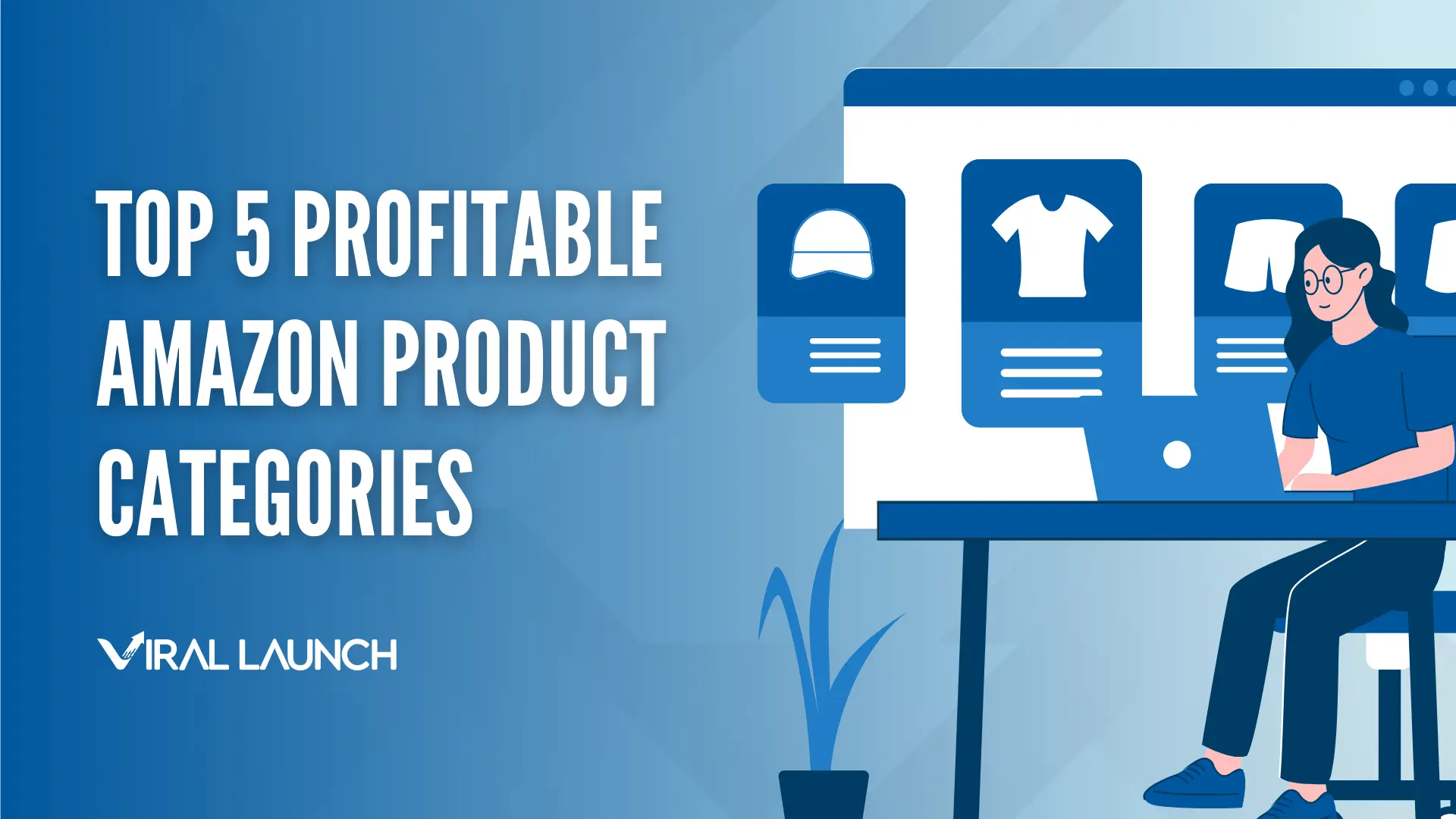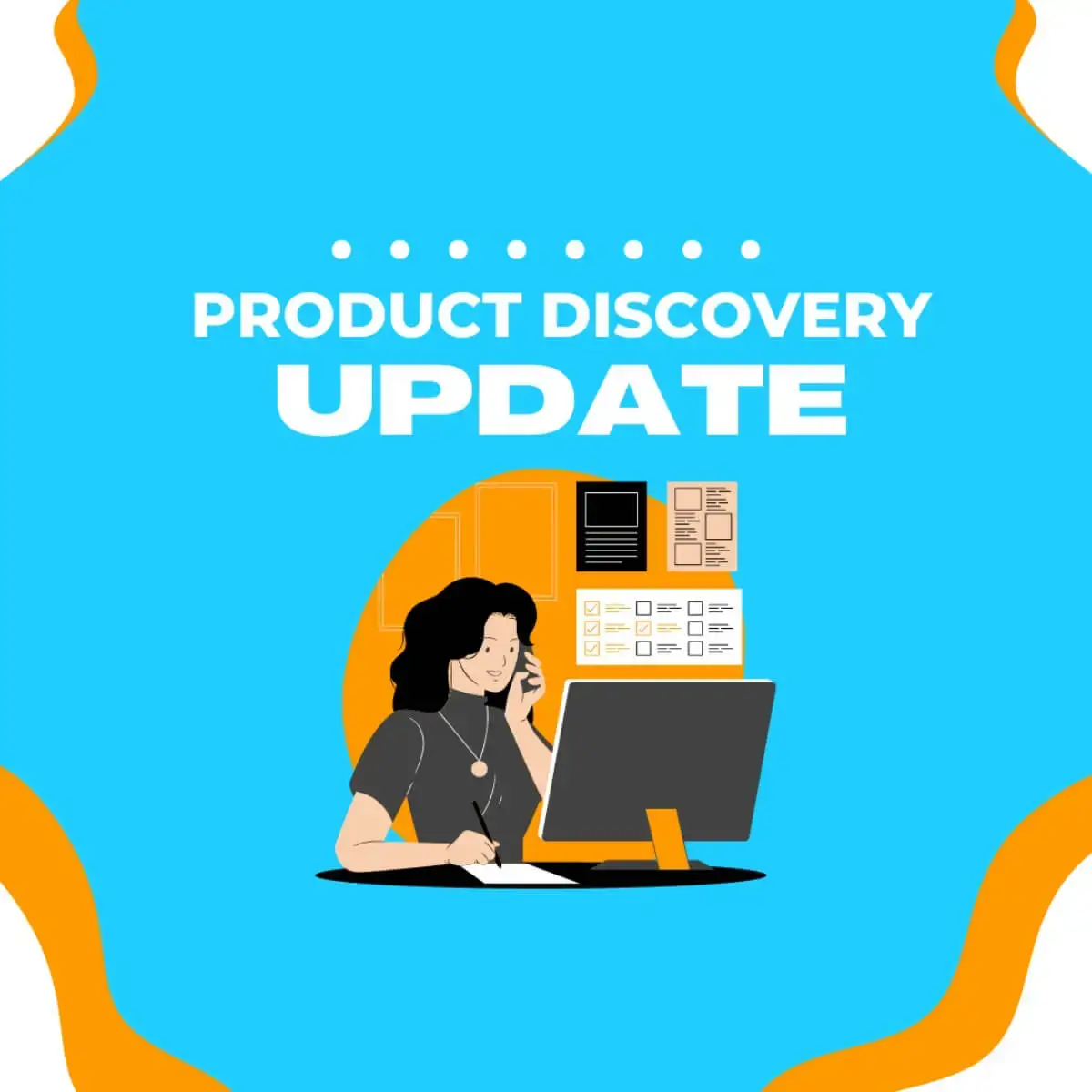The foundation of a successful Amazon business is great Amazon sales data. How’s that, you ask? Well, in order to have a successful Amazon business you have to have great products. And in order to source great products, you need to be able to identify great market opportunities. You need accurate and comprehensive Amazon sales data. We have hundreds of sellers come to us each month asking for help with their business. And why are they struggling? Poor product selection. Many of them have gotten into insanely competitive markets and don’t have the budget to achieve success. Others sourced products where they were forced to lower their price and now sell with razor-thin margins.
Many of these sellers even used a market research tool to determine whether or not to source. So what went wrong? Their Amazon data wasn’t giving them an accurate picture of the market. Most software is grossly inaccurate, calculating estimates using a single snapshot of BSR data
Where Other Amazon Product Research Tools Are Lacking
Snapshot Data
Most tools that use the Amazon Best Sellers Rank as their indicator for estimating sales are relying on the brief snapshot of what BSR is RIGHT NOW. Those tools are estimating sales over the last 30 days, based on a metric highly influenced by the last 24 hours. Using Snapshot data to analyze performance is like looking at a still frame of a movie and trying to predict the plot. It can be extremely inaccurate. As we discussed in our blog post covering the Amazon Best Sellers Rank (BSR) can vary drastically hour to hour, day to day, month to month, etc.
Using a product’s BSR to estimate sales can make a market look awesome one hour and completely different 12 hours later.
- Do you do your product research primarily on the weekends? Be careful. Consumer buying behavior in some product markets will affect BSR and those snapshot estimates over the weekend.
- Do you do your market research primarily in the mornings? Again, be careful. Some markets see higher sales in the morning hours, meaning BSR will be lower. That means that tools with snapshot estimates will show higher sales volume than they would if you did your product research at night.
To accurately estimate sales, you need to take into account all the fluctuations of BSR that occur throughout the month.
Have you ever tried doing product research during November and wondered if the estimated sales numbers were inflated due to holiday sales or if those numbers were consistent throughout the year? Perhaps you have done research on some of the weight loss products during January and February when sales are much higher than they are throughout the rest of the year. There are tons of consumer buying trends you may not be intuitively aware of, so how do you know the likelihood of your estimated sales numbers remaining consistent across time?
Not knowing how sales are trending across a market as a whole is dangerous when sourcing a product. To not have a complete picture of how sales trend throughout an entire calendar year for a product is kind of insane when you consider the amount of time and the thousands of dollars you spend getting initial inventory, creating a listing, and trying to gain traction.
ASIN Focused
Don’t look at just one ASIN. While some sellers may be well aware of this common fallacy, we’ve seen plenty who have unknowingly made this critical mistake. When doing research to determine which product markets you want to get into, you should be focused on the performance of the market as a whole, not a specific ASIN. Tracking how well a particular ASIN is performing in sales, keyword ranking, reviews, price, etc. is dangerous. There are so many potential external factors and reasons as to why sales are where they currently are.
Perhaps an ASIN with very few reviews but really high sales is only performing that well because the seller is a wizard at driving external traffic. Can you match that performance? There are plenty of reasons that sales may fluctuate per ASIN: running out of stock or driving external traffic. There are also plenty of reasons that price may fluctuate: split testing, temporarily attempting to push traffic. There are reasons that almost every metric you can track for a given ASIN may be fluctuating. But when you look at snapshot data, you don’t see the fluctuation, and you definitely don’t see what’s going on behind the scenes for that product.
Research should not be a question of “how well is this specific ASIN performing?” but a question of “what is the sales potential in this market?” Ask yourself what the barrier to entry is for the market, and what the opportunity to outsell the competition is. Both of these questions require you to look at all of the top competitors and analyze the whole market.
Validation
We work with the entire spectrum of sellers on Amazon. From large brand names to sellers trying to find their first item. For those in Facebook groups, I’m sure you’ve seen it a million times where someone posts a screenshot of the results from a sourcing tool where they ask “should I source this?” or “is this a good idea?” For every one of those posts, there are hundreds of sellers who don’t ask for help and end up getting into a product market where they waste precious resources: time and money.
At Viral Launch, we truly do believe that every product is a good product to sell so long as the numbers make sense for you. But there are some basic principles that make certain products absolutely great investments and others potentially risky. Think of it this way: if you’ve never been ice skating before, you’re probably not going to try competing against Olympic athletes the first time you lace up your skates. If you’re a new seller you don’t want to take on a highly competitive market like Vitamin C Serum. And even as an established seller, you might not want to take on a big brand like Tide in a market like Laundry Detergent. With the right knowledge, anyone can sell on Amazon. But that doesn’t mean anyone should sell in any market. And we believe your market research software should help you determine which markets are most favorable for you.
Product Suggestions
Imagine if you could snap your fingers and instantly know exactly which products you should source. That would be like every seller’s dream come true. And that’s why lists of hot products get so much attention. But a good product idea instantly becomes a bad product when it is easily accessible to many sellers. We have seen it plenty of times. Someone posts their list of hot new products, and within a couple of months, we have 20+ sellers come to us with those hot products. These product markets very quickly become saturated and the barrier to entry increases dramatically. Price wars cut margins in half, and suddenly that market that looked so good is terrible.
Unfortunately, for some sellers who have already placed inventory orders, by the time their product gets to FBA, the market has already turned sour. The way to avoid this nightmare scenario is to avoid products featured on these lists! We’ve seen it happen as a result of a product being mentioned by a guru or from popular webinars or demonstrations. The same can and does happen with programmatic product suggestions. That’s why Product Discovery offers warnings for popular results. Our goal is to help inspire new product ideas and then help you determine how great that idea is. Of course it would be incredible to have someone provide unlimited “secret” high potential product market suggestions. Unfortunately, it’s dangerous for the sellers who jump in.
Not Mobile Friendly
Our phones are a huge part of our lives these days. And we expect to be able to answer the questions that we have when we’re out to lunch or waiting for the subway. Market research software needs to be available in the same way that Google is available. It’s like your second brain. It’s right there when you need it. Because a product idea is going to hit you smack dab in the middle of your evening stroll around the neighborhood. Your best product ideas don’t always come when you’re sitting at your desktop. They probably come randomly, whether you’re out shopping, on your morning walk, in the bathroom, etc., having the opportunity to do a quick lookup on the go can be very helpful.
Stale Data
Most software in this space does not update their information or algorithms regularly allowing estimates to become stagnate and remain that way for longer than 6 months. A BSR of #1 in Beauty back in 2015 is a lot different than a BSR of #1 in Beauty in 2017. As Amazon continues to increase in popularity and more consumers shop on Amazon, the amount of sales any particular BSR represents, continues to increase.
Market Intelligence: Our Version of an Amazon Market Research Tool
Not Snapshot Data, Comprehensive Data
Amazon’s Best Sellers Rank can be extremely volatile hour to hour, day to day, and week to week. So in our mission to develop the world’s most accurate sales estimation tool, we had to build a tool that was going to take into account the vast fluctuations in BSR that occur all month, and we’ve done just that.
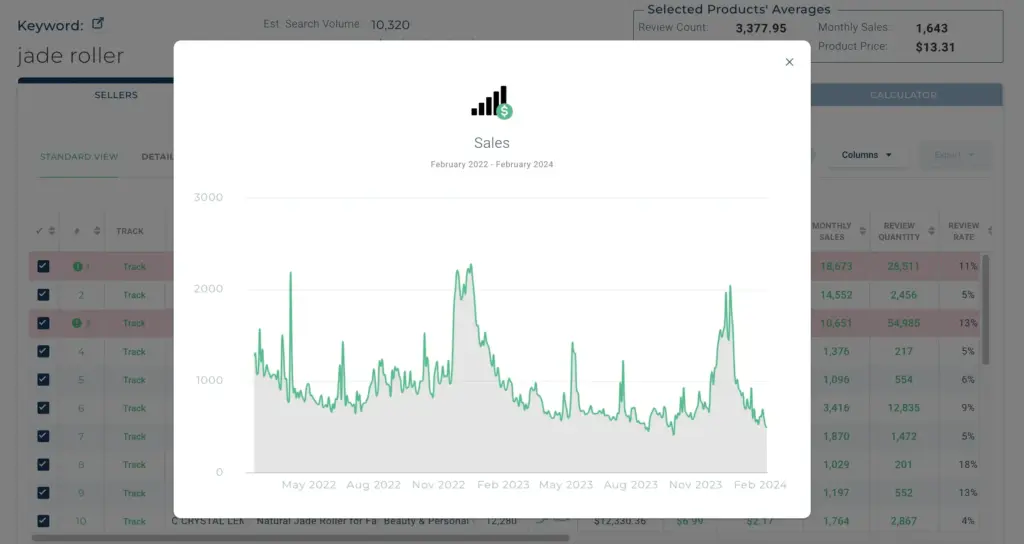
Our Amazon Market Intelligence tool tracks and analyzes seasonal trends and displays aggregated sales across the market for up to two years. This allows any seller to identify how seasonal consumer behavior may be affecting current sales numbers as well as how future seasonal trends may have an impact on future sales.
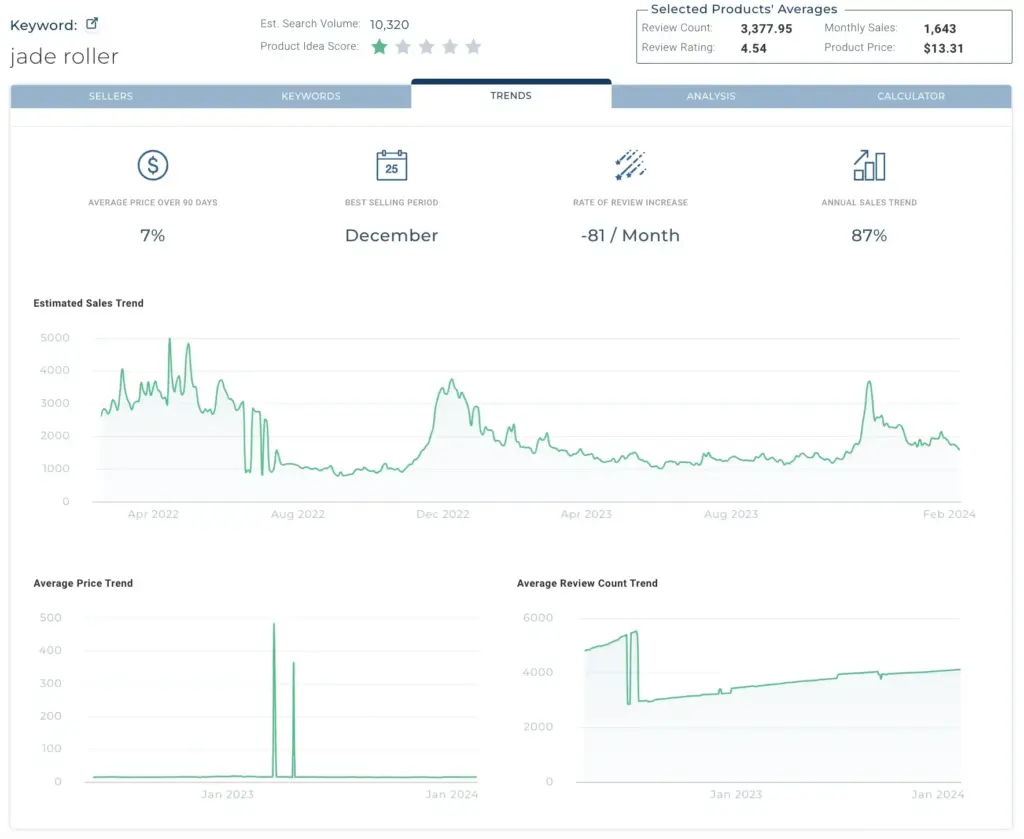

Not ASIN Focused, Market Focused
From our “outlier detection”, to our page of collective Market Trends (from sales to price to review quantity), to our Product Idea Score, we do our best to push users to focus on the principles of the market as a whole versus anticipating to replicate the results of a single ASIN.
Validation
Our Market Intelligence’s “VL Analysis” page is dedicated to helping sellers validate or invalidate their product idea providing them with a 1 – 5 star rating based on a customer algorithm analyzing an impressive number of market indicators. We go a step further and provide sellers with key tips, warnings, and alerts of the market if they do decide to enter in. This allows sellers a comprehensive view of a market’s potential outcome for success.


Not Product Suggestions, Product Idea Inspiration
While we are strongly against providing Amazon product/market ideas, we are very keen on providing inspiration or tactics of coming up with your own ideas! This is why we started our Sourcing Strategies to help you develop your own ideas to then research with our Market Intelligence software.
Not Stale Data, Fresh Data Every Day
Our Market Intelligence tool continually updates our BSR to sales mapping algorithm each night. This allows our calculation to remain severely accurate and consistent with the natural trends of the market. Due to seasonal trends across Amazon, as well as Amazon increasing in popularity, estimation tools that do not refresh their algorithm regularly will find their estimations quickly become stale and continue to decrease in accuracy as time goes on.
The Most Sophisticated Amazon Product Research Tool
There are three major components to our Amazon product research and validation software.
Market Research – Top Sellers
The market research component of our sourcing tool provides a view very similar to what most are used to. Essentially we grab the top ranking products for a provided search term.
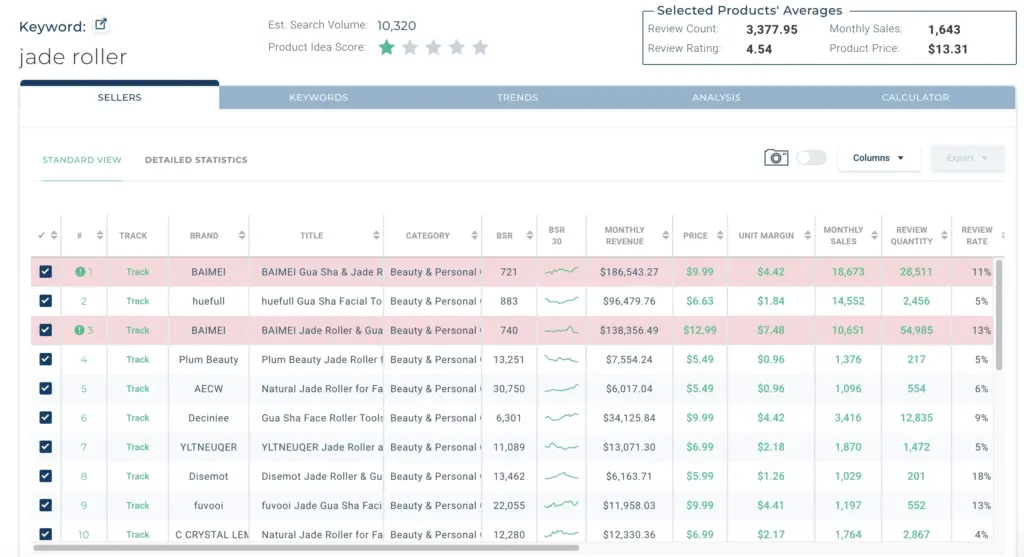

We provide data specific to each product such as brand, price, product title, estimated units sold over the last month (see why our sales estimation algorithm is more accurate than any other tool), review quantity, the sales to review ratio [[include link to another post]], net profit per unit, and estimated monthly net profit. If you click into any of the highlighted metrics you will be provided with historical data from the last 3-4 months. This is important for developing a better understanding of how products have been performing and what to expect if you happen to jump into the market.
Under the “Filtered View” tab, you will see essentially the same information with some rows of the table possibly highlighted in light pink. Highlighted rows depict market outliers. An outlier is a product we’ve determined to be statistically insignificant due to either their sales or reviews being far outside the market norm. The general rule of thumb is simply to ignore those listings.
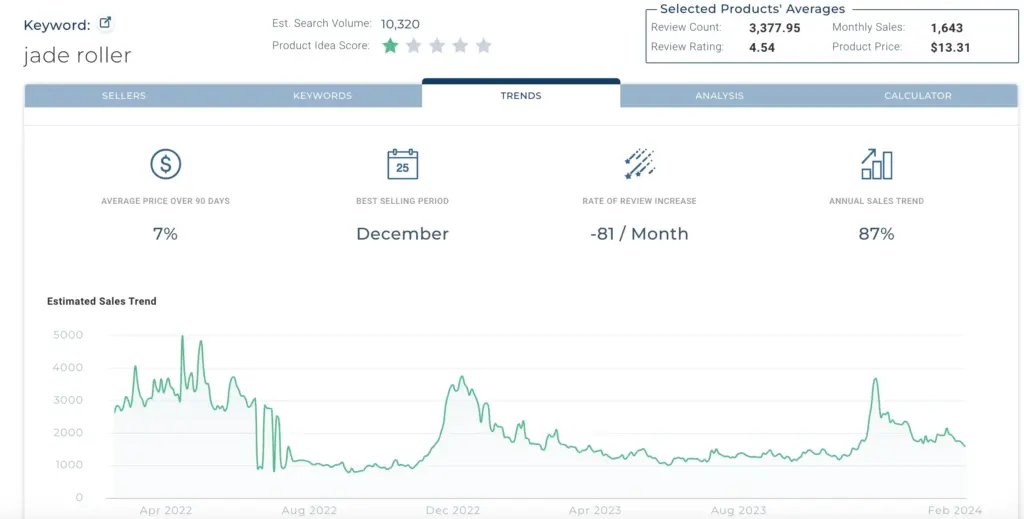

The “Competitive View” allows you to see important metrics also shown in the “Standard View” as well as the opportunity to see the product’s full image set and title. The intention here is to allow you to quickly identify the types of products potential competitors are selling for the given search term as well as identify possible areas where you could provide better creatives to out compete.
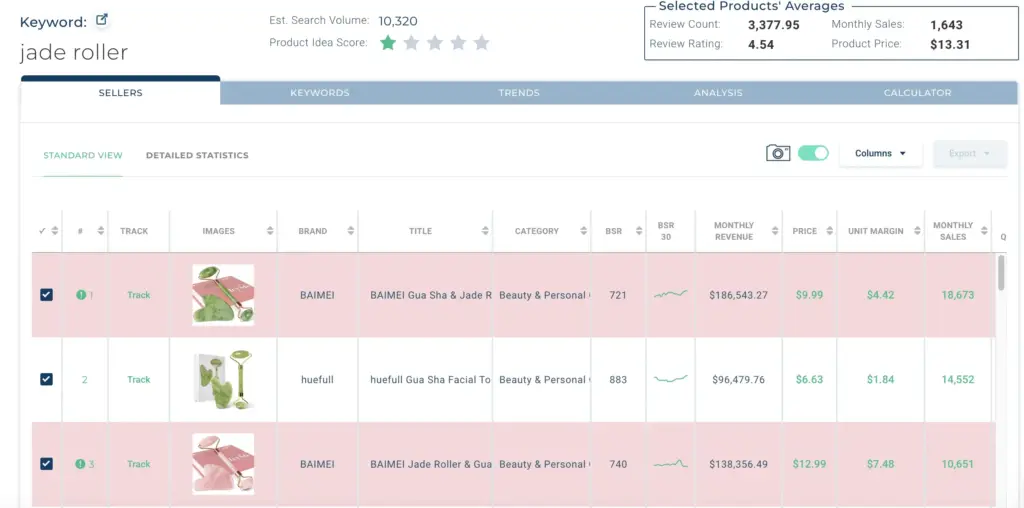

Clicking into an image allows you to quickly flip through each product’s image set.
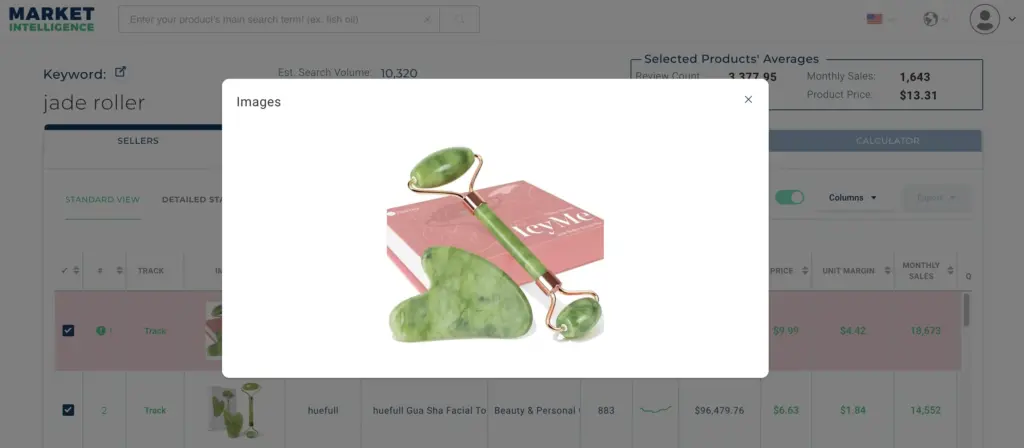

Market Trends
Making a sourcing decision based solely on the metrics of NOW can be incredibly dangerous. Our trends tool allows you to quickly identify how sales across the market have been trending over the last two years (provided data is available) as well as how the average price point and review quantity have trended. Has price been dropping significantly over the last 90 days? It may not be a great market to get into as margins look to be declining. Is the average review quantity growing at a relatively slow rate? May be an opportunity to come into the market with a better review funnel to outpace competitors and dominate the market.
For convenience we display how price has trended over the last 90 days in a simple percentage metric. We display the product’s best selling period throughout the calendar year. This can be a single month or a few months depending on consumer buying behavior. Finally we display, the rate of increase in reviews per month (ex. +10 reviews/month).
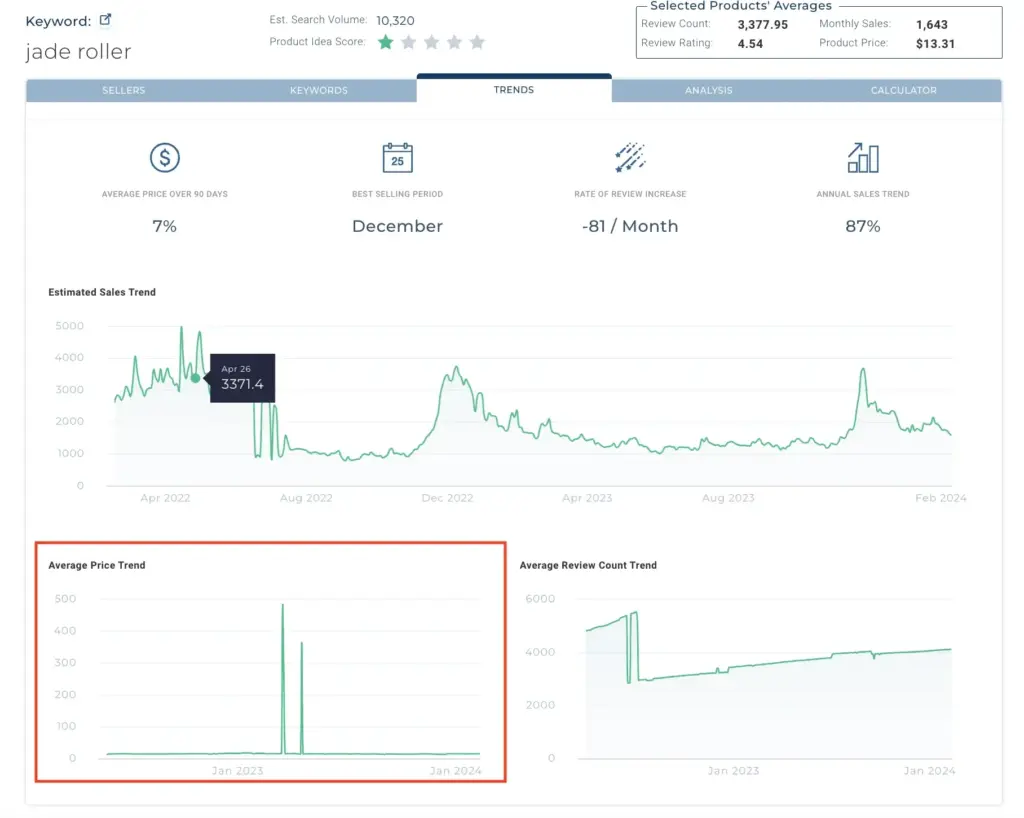

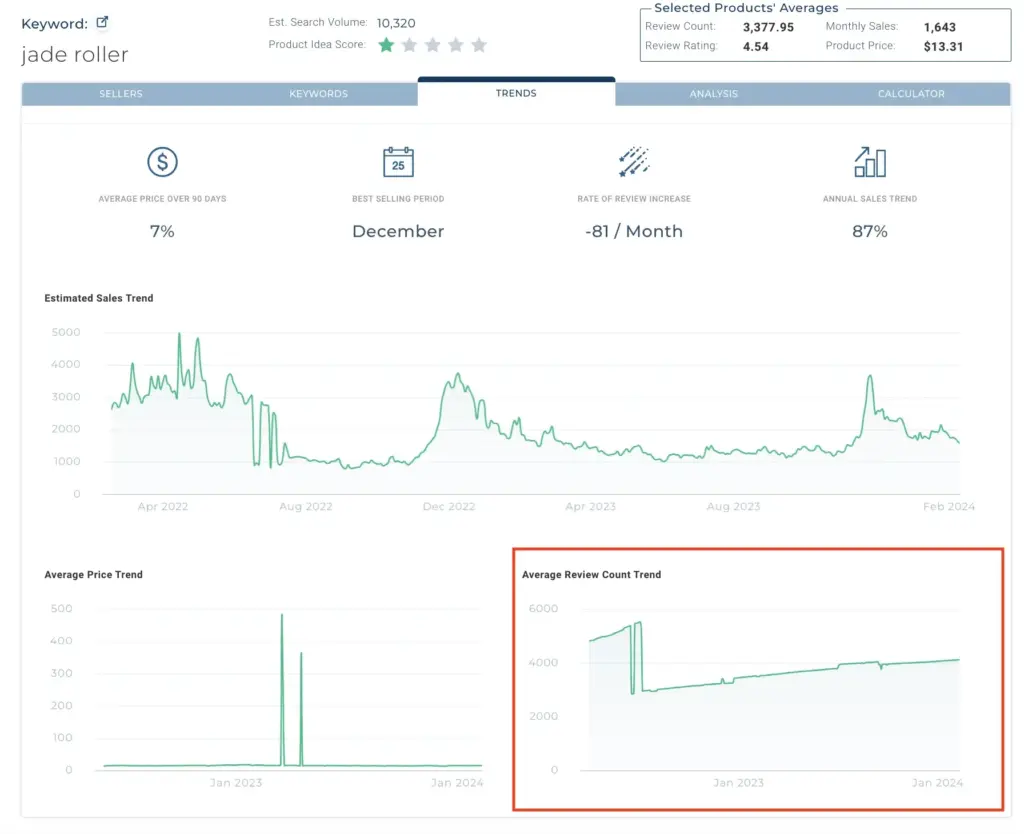

Viral Launch Analysis
The Viral Launch Analysis tab is our attempt at algorithmically helping sellers steer clear of money wasting products and into potential gold mines.
To kick off, we show our “Product Idea Score”, which is programmatically generated based on a large variety of factors and metrics both real time and historical. We’ve put all of our knowledge and experience running over 16,000 product launches, working with thousands of brands large and small, into this rating algorithm. A five-star product means that you’ve found a potential gold mine so long as you are comfortable with the provided numbers. A five-star rating means that the sales potential compared to relative barrier to entry is ideal, in addition to satisfying other market indicators we’ve identified contribute to successful products.
At the bottom of the page you will find our “Tips, Warnings, and Alerts” section. Here we try to bring to your attention some of the opportunities, topics to be aware of, and potential success crippling aspects of the given product market. An example of a tip would be to consider bundling the product as it appears others in the market are doing it with a degree of success. An example of a warning would that the average price point seems to be declining in the market so be cognizant of the potential cannibalizing of profit margin. An example of an alert would be a scenario in which page one is dominated by known name brands that are consuming the majority of the market share.
Other Features
Advanced Search
We’ve included two opportunities to customize the results based on your specific situation. Do you have a minimum monthly units sold threshold? Plug in your sales minimum and we will take this into account when calculating your Product Idea Score. Have an idea as to what the landed cost may be per unit for the product you’re looking to source? Plug that into the advanced parameters and we will take that into account when calculating the net Amazon profit for each product shown.
The Search For Smarter Sourcing Decisions
We didn’t build our Amazon product research tool because we thought we could make money if we provided a marginal improvement on a tool similar to what others before us had created. We HAD to create this tool to help sellers avoid the potentially tens of thousands spent getting into product markets they have no business being in. We are now starting to manage more and more accounts as a company and we needed accurate market data. It’s impossible to make accurate future projections without knowing where the market has been. The old adage, “you have to know where you’ve been in order to know where you’re going” is incredibly relevant to jumping into a product market.



